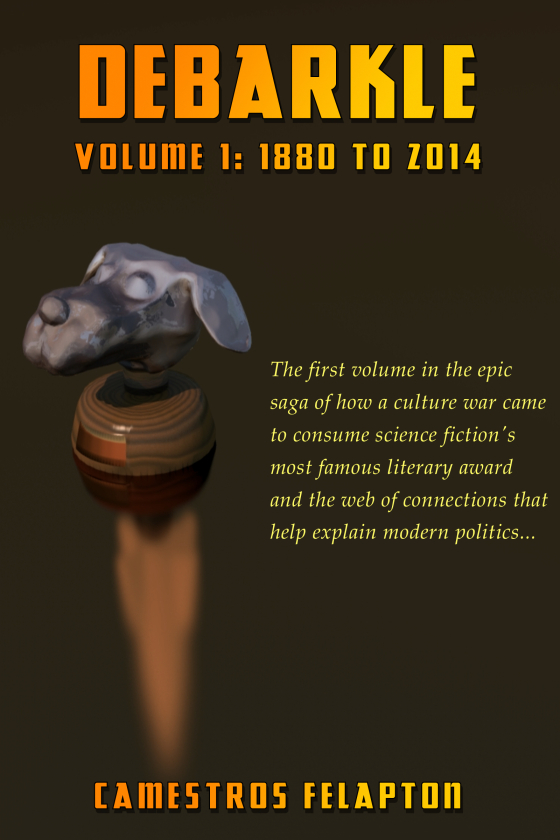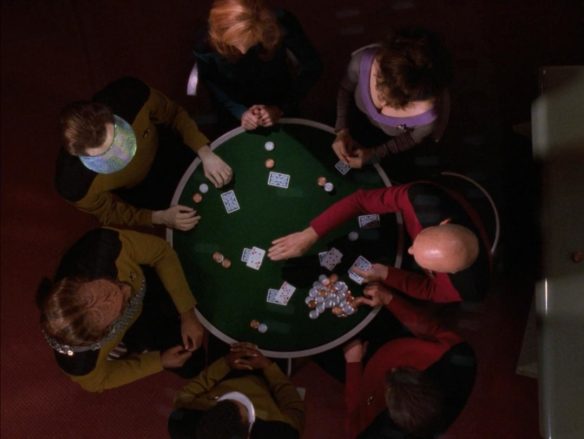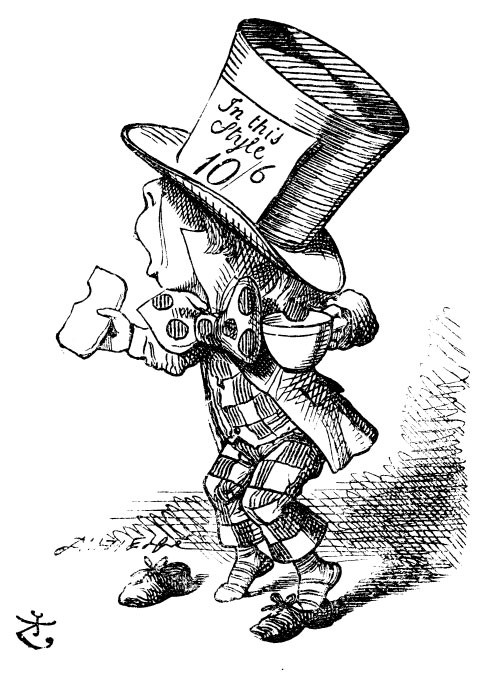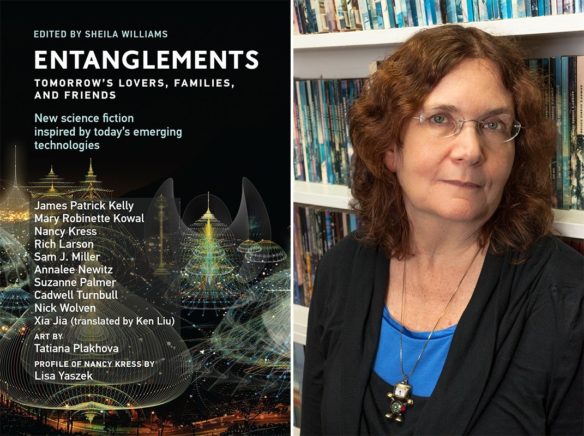(1) OUT OF KABUL. Allyson Reneau, who first met the girls through her work on the board of directors for Explore Mars, helped extract the “Afghan Girls Robotic Team, a group of girls ages 16-18 who have overcome hardship in order to pursue their love of engineering and robotics in Afghanistan.” “Oklahoma mom helps rescue 10 girls on Afghanistan’s robotics team” at Today.
…But it wasn’t as simple as organizing documents and the girls getting on the plane.
“They were in a sea of chaos with eight million people and a city halfway around the world,” Reneau told TODAY, adding that unrest in Kabul worked against the effort. “A lot of the work I’ve done with the embassy has been all night, and I have to work all day. It’s been exhausting.”
“It’s very narrow window of opportunity,” she said of the effort. “I knew that if I didn’t run through that door now — it’s now or never. Sometimes you only get one chance.”
After a cancelled flight, ten girls from the team were successfully evacuated.
“We were able to get them on the U.S. military side (of the airport), so they were protected over there waiting (and) the next text I got was that they were airborne,” Reneau said….
(2) MUCH IS NOT KNOWN. Historian Adrian Goldsworthy also writes books set in the Roman empire. “The Big Idea: Adrian Goldsworthy” at Whatever talks about the challenges.
The Big Idea behind The Fort is trying to understand what the world was like at the beginning of the second century. In my day job I write non fiction history books, and have been studying the Roman empire and the Roman army for all my adult life. So writing a novel in that setting gives me a chance to work out what I have learned from all this about life at the time and then push the evidence as far as it will go. There is so much that we do not know about the ancient world, which means that in a novel you have to imagine and invent to make the world of the story complete and convincing.
(3) FOUNDATION. Apple TV+ will stream Foundation beginning September 24. Here’s the new trailer.
The fate of an entire galaxy rests on the beliefs of Dr. Hari Seldon (Jared Harris). Will his conviction save humanity or doom it? Based on the award-winning novels by Isaac Asimov, Foundation chronicles a band of exiles on their monumental journey to save humanity and rebuild civilization amid the fall of the Galactic Empire.
(4) BEGINNINGS. Lightspeed Magazine’s Author Spotlight shines on Tobi Ogundiran, whose story “The Tale of Jaja and Canti” is in the new issue.
How did you get into writing genre fiction?
Growing up in Nigeria, I constantly heard tales which would ordinarily seem too far-fetched to be true. But they were true. And this helped shape my understanding of the world, in that the lens through which you view life affects how you experience it. This, coupled with the fact that as a teen I read so much Stephen King and Harry Potter, I guess it was inevitable that when I finally decided to put pen to paper, to craft my own stories, the stories that came were fantastic in nature. The realization that what I wrote was genre only came later.
(5) BRADBURY 100 LIVE THIS WEEKEND. Phil Nichols invites Bradbury fans to view Bradbury 100 LIVE on Saturday, August 21:
On the eve of the 101st anniversary of the birth of Ray Bradbury, Phil Nichols invites you to a livestream of Bradbury 100.
WATCH the livestream, in the Ray Bradbury Fan Club Facebook group, or on the Bradbury 100 Facebook page.
OR:
JOIN IN the discussion, by joining the Zoom meeting (scroll down for Zoom link).
Phil will be joined by writer Steven Paul Leiva, who was the guest on the very first episode of the Bradbury 100 podcast. Steven, you may recall, was the driving force behind “Ray Bradbury Week” in Los Angeles in 2010, when Ray was 90 years old.
The livestream will include some never-before-seen footage from Ray’s 90th birthday party.
Here is the Zoom link.
(6) MS. A year from today the “J.R.R. Tolkien: The Art of the Manuscript” exhibit opens at the Raynor Memorial Libraries at Marquette University. It will run from August 19-December 12, 2022.

Marquette University’s Raynor Memorial Libraries and the Haggerty Museum of Art are pleased to announce an upcoming exhibition of manuscripts from the celebrated author and artist J. R. R. Tolkien (1892-1973), best known for his literary classics The Hobbit and The Lord of the Rings.
The exhibition considers Tolkien’s work through the lens of manuscripts, both in terms of the materials he studied as a medieval philologist and the manuscripts he created while developing his legendarium. Professor Tolkien was deeply immersed in the complexities of manuscripts, and this exhibition will illustrate how different aspects of the manuscript tradition found expression within Tolkien’s scholarly life and in his creative writing.
The foundation for this exhibition is Marquette University’s extensive collection of Tolkien manuscripts housed within the library’s Department of Special Collections and University Archives; but it will also include items borrowed from other repositories, including a significant number of Tolkien manuscripts and artwork from the Bodleian Libraries at the University of Oxford.
The exhibition will include over 100 items, many of which have not been exhibited or published.
Additional details are available in a brief FAQ. More information will be made available as the exhibition’s opening approaches!
(7) CHARACTERS IN PAIN. Sarah Chorn draws on personal experience to offer “Ten tips for writing believable pain” at Bookworm Blues.
2. Pain will change your mood.
When I’m hurting really bad, my entire neighborhood probably knows to stay away from me. Pain tends to change moods, and everyone is different. Some people get really quiet and withdrawn. Some people get angry. I seem to become an absolutely intoxicating blend of both of those. Some people try to power through it by being overly happy. Some get depressed. Regardless, if your character hurts, they will have an altered mood, at least during the most intense part of their pain. Depending on who you are writing, they’ll react differently. I don’t know many people who get hurt, and then keep on going with their mood completely unaffected. Even if they act unaffected, inside, they’re probably screaming, and think of the energy it takes to hide that scream.
The thing to remember is, pain is going to take up part of your headspace. If you had your whole mind focused on defeating the emperor, and then you take an arrow to the shoulder, now 40% of your thoughts are going to be on defeating the emperor, and 60% are going to be focused on the pain you are feeling (Or something. You get the point.). Pain takes up space. It just does. Don’t think of it as something you feel. Think of pain as an uninvited guest, and now you have to make room for it because, depending on the injury and the timeline to healing (if there is a “healing”), that guest isn’t going anywhere. You have to feed your guest. Pain feeds on energy, and energy impacts mood. So keep that in mind when you write your injured character.
(8) MAKE ROOM! In the latest Rite Gud podcast, Raquel S. Benedict is joined by MK Anderson to discuss “This Is My Hole: On Negative Space and Leaving Room for the Reader”.
A story is a type of conversation with the reader. If you don’t leave room for the reader to speak, you’re a terrible conversationalist. This room, this essential emptiness, is called negative space. In this episode of Rite Gud, we discuss why the words you don’t write are just as important as the words you do.
(9) BANKS ROBBERY. Matt Bell lists his favorite sf and fantasy novels where characters steal things in “Eight Science Fiction and Fantasy Heist Novels” at CrimeReads. One of them is —
Consider Phlebas by Iain M. Banks
In one of the early set pieces of Consider Phlebas, Horza is rescued/captured by the pirate crew of the Clear Air Turbulence (one of Banks’ fantastically named Culture ships), who are on their way to the planet Marjoin to rob the Temple of Light, a target described by the ship’s captain as easy in, easy out: “According to him,” one pirate says, “it’s full of priests and treasure; we shoot the former and grab the latter.” It’s a simple plan, but even the best-laid plans usually go sideways in heist narratives, and this one is no different: the Marjoin monks turn out to be heavily armed, and their temple is a trap made entirely of reflective surfaces that bounce the pirates’ lasers back at them—which means the pirates get to do very little pillaging and a lot of running for their lives.
(10) MEMORY LANE.
- 1958 – Sixty-three years ago in the August issue of The Magazine of Fantasy and Science Fiction, Robert Heinlein’s Have Spacesuit – Will Travel was first published. (Anthony Boucher will announce his departure as editor in this issue.) The cover illustration is for this novel. Charles Scribner’s Sons will publish it in hardcover the next month. It was nominated at Detention for a Hugo, the year Blish’s A Case of Conscience won. It would be nominated for BSFA’s Fiftieth Anniversary Award: Best Novel of 1958 but that Award instead would go to Brian Aldiss’ Non-Stop.
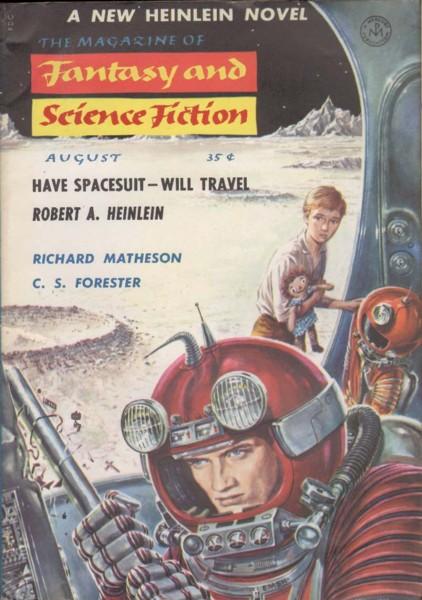
(11) TODAY’S BIRTHDAYS.
[Compiled by Cat Eldridge.]
- Born August 19, 1893 — Hans Waldemar Wessolowski. An artist best remembered for his cover art for pulp magazines like Amazing Stories, Astounding Stories, Clues and Strange Tales. Wesso was the name most commonly cited wherever his art is given credit. Wesso painted all 34 covers of the Clayton Magazines Astounding Stories from January 1930 to March 1933. He was nominated for a Retro Hugo for Best Professional Artist at Loncon 3. (Died 1947.)
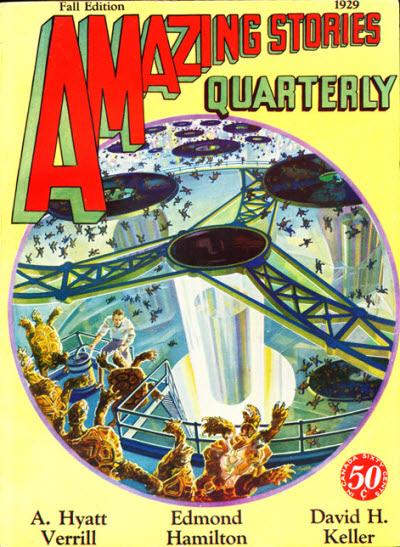
- Born August 19, 1921 — Gene Roddenberry. Oh, you know who he is. But did you know he wrote a lot of scripts for Have Gun – Will Travel? Indeed his script for the show, “Helen of Abajinian” would win the Writer’s Guild of America award for Best Teleplay in 1958. And yes, he would share a Hugo for Star Trek’s “The City on the Edge of Forever” episode which was awarded at Baycon. (Died 1991.)
- Born August 19, 1928 — Richard N. Farmer. Author of Islandia Revisited, a sequel to Austin Tappan Wright’s Islandia. No idea it was if authorized. It’s not in print in either print or digital editions currently. Anyone here read it? (Died 1987.)
- Born August 19, 1930 — D.G. Compton, 91. SWFA Author Emeritus whose The Steel Crocodile was nominated for the Nebula Award. The Unsleeping Eye, The Continuous Katherine Mortenhoe in the U.K., was filmed as Death Watch which the Audience Reviewers at Rotten Tomatoes actually like giving it a 60% rating. His two Alec Jordan near future police stories are superb. He recently was selected for the Cordwainer Smith Rediscovery Award.
- Born August 19, 1938 — Diana Muldaur, 83. She appeared in the original series in two episodes, first in “Return to Tomorrow” as Dr. Ann Mulhall / Thalassa and then in then in “Is There in Truth No Beauty?” as Dr. Miranda Jones. She, of course, is up again in Next Gen as Dr. Katherine Pulaski. She voiced Dr. Leslie Thompkins in that animated Batman series as well.
- Born August 19, 1950 — Jill St. John, 71. She’s best remembered as Tiffany Case, the Bond girl in Diamonds Are Forever. She was the first American to play a Bond girl. She shows in The Batman in “Smack in the Middle” and “Hi Diddle Riddle” as Molly. And she played Jennifer Holmes in the 1960 film version of The Lost World. Even more fascinatingly she’s one of the uncredited dancers on Rowan & Martin’s Laugh-In!
- Born August 19, 1950 — Mary Doria Russell, 71. The Sparrow series, The Sparrow and its sequel Children of God, are awesome. The Sparrow won the Clarke, BSFA, and Tiptree Awards, and it was the reason she won the Astounding Award for Best New Writer. Though not genre, Doc and its sequel Epitaph are mysteries using the historic character of Doc Holliday.
- Born August 19, 1952 — Jonathan Frakes, 69. Best known for his portrayal of Commander William T. Riker in Next Gen and I’m fond of his voicing David Xanatos on the Gargoyles series which had at least five Trek actors doing voice work. Interesting bit of trivia: For a time in the Seventies, he worked for Marvel Comics at Cons as Captain America. He has directed more than seventy television episodes, including episodes of myriad Trek series, Marvel’s Agents of S.H.I.E.L.D., Leverage, The Librarians and The Orville.
(12) MOSLEY’S THING. Renowned storyteller Walter Mosley, known for his definitive and bestselling international work in mystery and crime fiction, will be writing a six-issue series of The Thing for Marvel in November 2021.
Written by Mosley and with art by Tom Reilly (X-Men: Marvels Snapshots), the story will range from the urban sprawl of the alleys of Manhattan to the furthest reaches of the cosmos itself. In THE THING, a lonely evening and a chance encounter (or is it?) sends Ben Grimm embarking on a sojourn that will have him confronting—and battling—figures both old and new.
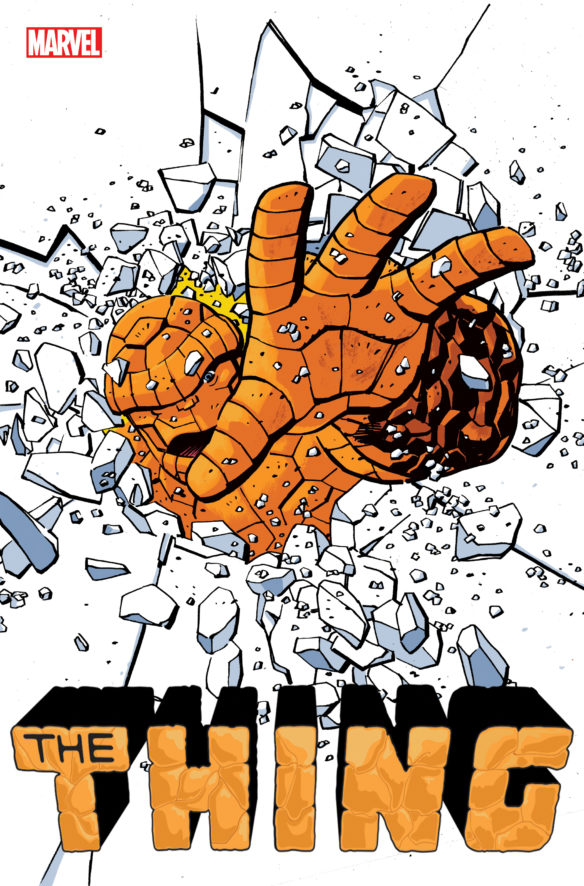
(13) A COMIC BOOK LIKE YOU’VE NEVER SEEN. Atlas Obscura shows off “The 36-Pound Comic Scrapbook That Chronicles the Great Depression”. This unusual artifact—now housed at the Columbia University Libraries—is part comic collection, part journal of life in the 1930s.
“DEAR FRIENDS OF MINE, Please write a line / In this little Wash Tubbs book of mine. / Help me Keep you in my Mind”
So begins the inscription on the spine of a hulking tome that was once a source of idle amusement for clients at the Bungalow, a barbershop in Fredonia, Kansas. In 1928, the barber, I.A. Persinger, began compiling this collection of “Wash Tubbs” comics, a well-loved daily newspaper strip by artist Roy Crane, whose adventure graphics popularized the visual sound effects—Bam! Pow!—we know so well today. Soon, though, the scrapbook expanded with handwritten insights from Persinger and his customers on life during the Great Depression….
(14) ONLINE PUPPETRY EVENT. There’s a charge to participate in the 2nd Virtual National Capital Puppetry Festival happening from August 19-22, but the trailer is free and fun.
(15) PIECES OF EIGHT. Octothorpe episode 38 is “How the Sausage is Made”, which in lesser hands might be a great argument for dietary restrictions. John Coxon, Alison Scott, and Liz Batty say —
We record around a dining room table using a single mic while our partners and friends were in a brewery without us. As a consequence, it’s a snappy episode this week…

(16) HE-MAN. Netflix dropped a trailer for the new series of “He-Man and the Masters of the Universe”.
He-Man and his powerful friends learn what it means to be a hero while battling the evil forces of Skeletor and his minions.
(17) ETERNALS VIGILANCE. Marvel Studios promises this is the Eternals Final Trailer. I’m going to hold them to it.
(18) VIDEO OF THE DAY. The King of Random explains why it’s really hard to create a Rube Goldberg machine!
[Thanks to Cat Eldridge, Mike Kennedy, Andrew Porter, Paul Weimer, R.S. Benedict, John Coxon, Martin Morse Wooster, JJ, Michael Toman, and John King Tarpinian for some of these stories. Title credit belongs to contributing editor of the day Jon Meltzer.]

